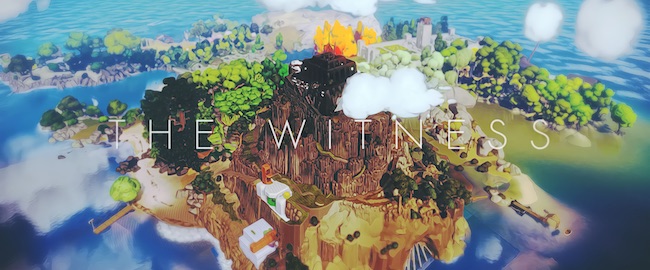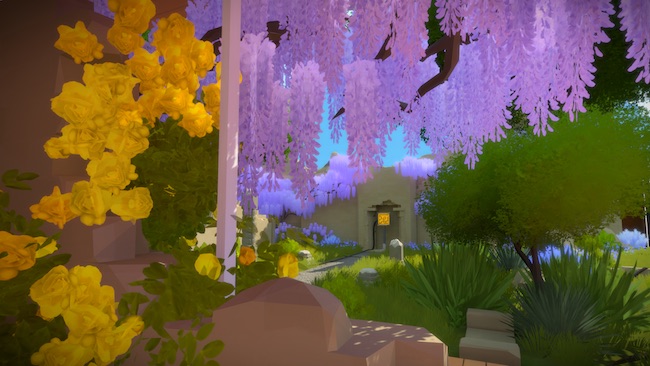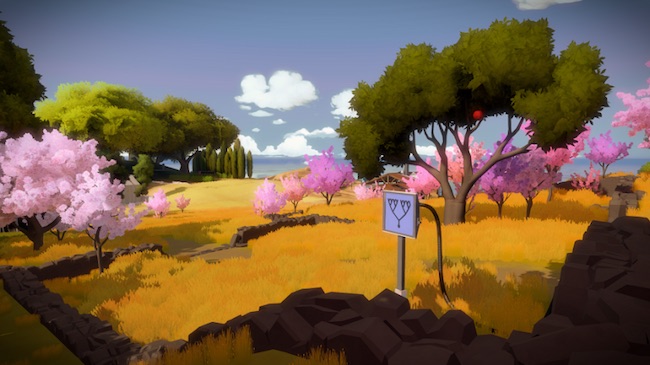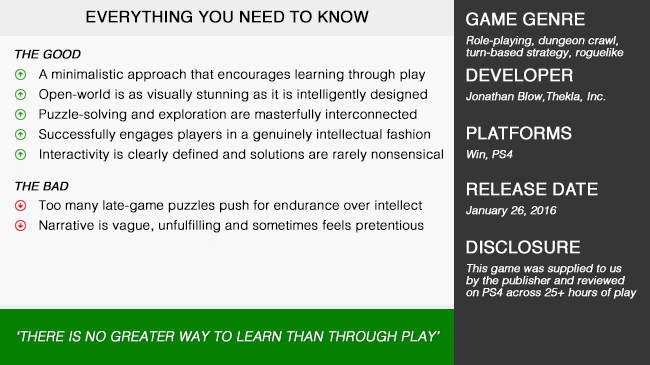
Renowned independent developer Jonathan Blow’s debut title (Braid, a 2D time manipulating puzzle-platformer) was more than just your typical Xbox Arcade release; it was something truly special. Having been cited by countless developers as a source of inspiration—as well as heavily featured in the 2012 documentary, Indie Game: The Movie—Braid has even come to be considered by many as the title that launched a wider interest in independently-developed games starting 2008 and onward. Sure, this indie-superstar has expressed his share of controversial opinions about the games industry in the media, but if one thing is clear, this deep thinker (and former physics major) wants more from games. It’s an ambition that has led Jonathan and his team (yes, it’s not just one man) on an arduous journey that finally concludes this month—near eight years since inception—with the release of his second title, The Witness.

I first feel obligated to clarify that while I have not played the 1993 graphic adventure puzzle, Myst—which clearly inspired many elements of The Witness—I did research the game prior to my review to understand why it was so successful and where it drew criticism. Blow has stated in the past that he wanted to recreate Myst’s successes while avoiding its missteps. Although, it’s important to note the two games don’t play anything alike—they just branch out from a similar design ideology. From what I learned, Myst was mostly criticised for nonsensical puzzles that interfered with the pacing of exploration as well as the driving mystery, and, from the get-go, it’s clear that The Witness strived to avoid this pitfall. Both puzzle-solving and exploration are masterfully interconnected in this game, and in a way that is so seamless that the designers didn’t need to provide any instructions for the player. You learn how to play by playing.
Your journey on this mysterious island opens with an unnamed player character standing at the end of a long hallway—there is no main menu, introduction or exposition whatsoever. You walk forward to eventually find a door, on which there is a simple puzzle that must be solved in order to progress. This process is the core essence of the experience as well as the player’s first lesson. Essentially, the game is a series of maze-like puzzles that are scattered throughout an open-world. Apart from solving them, there is no clear objective. There are no limits on where you can go, and there are no obstacles you will face other than your own lack of knowledge. However, if you can successfully complete an entire series of puzzles, you’ll activate a laser that turns to point towards the top of a strange mountain at the edge of the island. You’re not sure why exactly, but like another indie-hit, Journey, it’s about learning to follow your instincts.

What makes exploration compelling, as well as easy to manage, is how defined the world itself is as each area has a distinct visual appearance. Using a vibrant minimalistic art style, Blow and his team allow the player to know exactly where they are without the need for a map, and, what’s better yet, is that each area houses its own unique puzzle type. Upon reaching a new location, more often than not you’ll find a row of terminals that introduce you to a new style of puzzle. The game ensures you always have the tools you need, and if something doesn’t yet make sense, you can always wander off to tackle a new area and come back with a fresh perspective. What’s great, too, is the answers are always immediately nearby. Maybe not on the terminal itself, but hidden in plain sight. You are never left poking around the environment trying to work out what’s interactive and what’s not, and I was very appreciative of this design choice.
In a game that appears to be almost entirely about solving maze puzzles, it’s important to understand that while it’s true this is the core of the game’s interactivity, the environment itself is just as significant. One thing that might surprise players too is that there is no music whatsoever, which is critical to the experience. The surroundings are beautiful, and from an exploration point of view, they’re a joy to uncover as each is so memorable—but it’s also this way for a reason, and not just to help you know where you are. There are an incredible variety of puzzles being offered in The Witness, and many solutions are not restricted to the maze itself. Light, shadows, colours, sound, viewing angles, just to name a few, are some of the many ways this game will try to boggle your mind and force you to think outside the box. It’s quite remarkable how many excellent ideas are fleshed out, with few ever falling into the realm of nonsensical.

For the first three-quarters of the experience, I wholeheartedly thought The Witness was one of the best puzzle games I had ever played. The freedom, the challenge, the minimalist design, its outside of the box way thinking—there is so much about it that I believe is genuinely outstanding. However, as I reached the final stages of the game, my sense of progression started to feel very fatigued. The process changed, and the game shifted to focus more on a culmination of mixed puzzles from previous areas of the game. In theory, it makes sense, and it should have been about putting everything you’ve learned to the test, but it did not work out that way. Without a good progression curve, each puzzle started to feel like a brick wall, and from that point on, too many just became obnoxiously involved. I knew I could solve them—they required time more than intellect—but it stopped being fun, and it honestly made me want to cheat.
I’m also critical of the final hours of the game because I was expecting some sort a payoff for the amount of energy I invested, and there wasn’t one. When I reached the credits, I mostly just walked away feeling mentally drained. Until now, I’ve neglected to mention there is a vague narrative that is explored through audio logs that you’ll find scattered throughout the island. Basically, they’re all inspirational quotes from famous people throughout history and mostly pertain to uplifting messages about human potential. Personally speaking, I like the quotes, but they felt oddly out of place in The Witness—as if the developers were too obviously trying to point out our potential as the player. The game already does that without the need for words, so what started as an array of positive messages slowly culminated into a pretentious undertone. I get what they were aiming for, but it felt preachy and the ending left me feeling a bit hollow.

Fundamentally speaking, The Witness is almost certainly one of the best puzzle games I’ve ever played. There are few things I appreciate more in game design than an opportunity to learn through play, and I applaud Jonathan Blow and his team at Thekla Inc. for crafting such a minimalistic yet innovative puzzle-solving experience. It’s not only visually stunning, it’s filled with incredible ideas that will push players of all skill levels to think outside of the box. It’s also for this reason I can’t help but feel disappointed that it gets bogged down leading up to the final hours of the game—too frequently pushing for endurance over intellect—and then closing out on a bit of a pretentious note. You’ll be smarter having played it, but it’s kind of self-defeating if that needs to be pointed out. However, looking over my experience as a whole (25+ hours, 450 puzzles, and many secrets), I can still highly recommend The Witness. It’s an excellent game.











